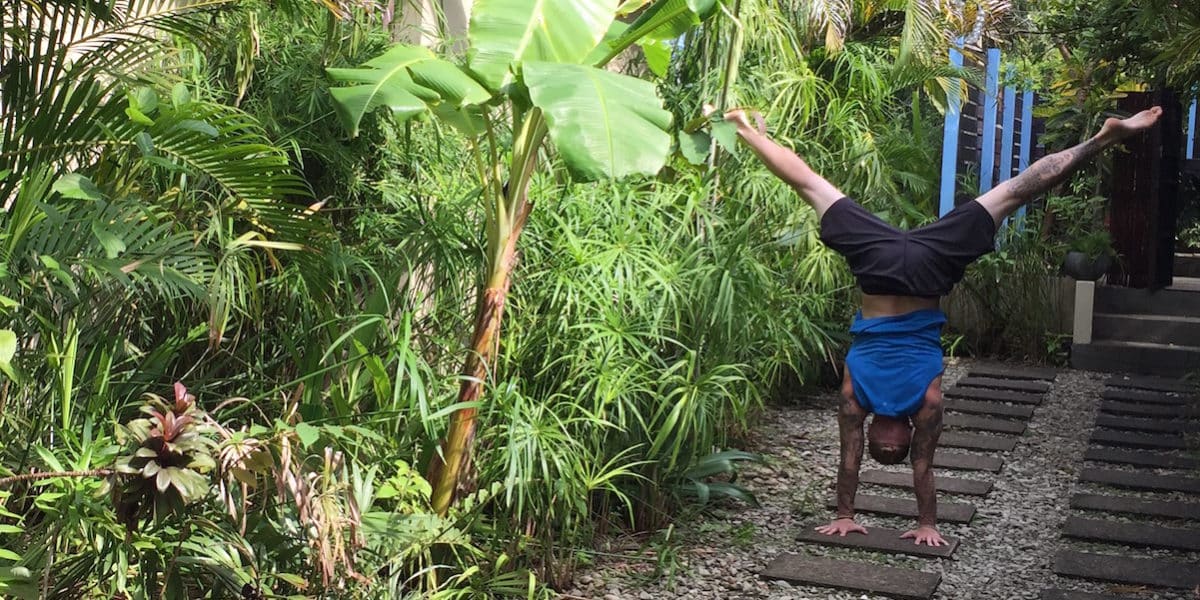Kyle Weiger
Share This
In the broad world of fitness, Handstand seems to be the most coveted physical pose across a variety of modalities: Yoga, CrossFit, Gymnastics, and so on. People all over the world are captivated, moved, perplexed, and sometimes downright confused by the ability of a human being to hold themselves totally vertical while on their hands.
Why, oh why, is this one common position so interesting to so many people? I mean, CrossFitters don’t really care that much about Warrior II. Let’s be honest Yogis, we aren’t that interested in the clean and jerk. So why Handstand?
Well, let’s start with the fact that our species naturally walks upright, and sleeps horizontal. Thus, there is nothing in our anatomical makeup that suggests that we belong upside-down. It’s the most possibly abnormal proposition you can ask of your body.
What does your brain think about inverting?
Developmental Psychology says that the human brain comes pre-loaded with two basics fears installed on it:
#1: The fear of loud noises.
#2: The fear of falling.
When you first start inverting your body, your brain sends signals to your body that you are, in fact, falling. It’s one of your body’s natural survival mechanisms to alert you of danger. It’s that same instinct that wakes you from sleep when you have that dream where you step off a ledge and the ground isn’t there. It jerks you out of sleep like an electric shock… or am I the only one who has that dream??
Simplifying Handstand
So, how do we break down this intricate and beautiful specimen of physicality? Well, let’s look at the components of handstand, and how many times they occur during your regular yoga practice:
Feet together,
Knees together
Hips and shoulders in a line (meaning you aren’t twisting or side-bending)
Active belly
Arms straight
Body symmetry – the right and left side are the same
Hmmm… it seems like I’ve seen these somewhere else…
Mountain Pose
Plank
Downdog
Chair
Boat
Crane
All of these poses embody the components of Handstand; they’re just packaged a little differently. So let’s unpack them a bit and see where we can make some progress. The most obvious example is Mountain Pose since it very clearly resembles an upside down Handstand. Downdog is a Pike Handstand rotated 90 degrees and Chair Pose is a Tuck Handstand rotated 180 degrees. Boat and Crane are almost identical shapes that, when uncurled, result in a straight line.
In all of these postures the Sagittal Plane is never broken, meaning no body part crosses over the midline. Imagine a giant sheet of glass running through the vertical center line of your body….in a very non-violent Ahimsa sort of way of course.
So just by the very virtue of your asana practice, Handstand is very much within your grasp since your body already knows the individual components. To put all of them together, I’ve always been a big fan of finding the easiest orientation of the pose and starting there.
Hollow – Try Handstand While Laying Down
For example, if you make the shape of handstand while lying on the ground, it’s a position that gymnasts refer to as Hollow. Rather than connecting to the ground on your tail like in Boat, imagine your low back being connected to the ground with your tailbone lifted slightly, along with you shoulders. While keeping your back in place, stretch your arms and legs as long as you can.
Pro Tip: If you want a clean and strong handstand line, get intimately familiar with Hollow.
Once you start to get your Hollow shape on the ground and it feels strong, take it to the wall….but not in the way you think. Yogis love to kick up to a wall facing the middle of the room, and although this is the path of least resistance, it’s also the least effective.
The best way to use a wall is to do your handstand facing it. The drill goes by the easy-to-remember name of “Nose & Toes” simply because once you walk your body into the wall, you drop your head and Hollow out your body so that only your nose and your toes are connected to the wall. This very quickly solves the biggest problem that most yogis face in their Handstand…the dreaded sway back.
While most of the beautiful practice of yoga lends itself to the freedom of spinal extension and heart opening, Handstand is one pose where we want to remember to tuck things inward.
All in all folks, Handstands are fun because they are challenging and empowering at the same time, but please, I beg of you, don’t put any pressure on this pose because it’s coveted by so many. Being able to do a handstand is just a physical skill to be learned over time. Take the woo-woo out of it and look at it as a very achievable shape.
Easy.
Kyle


